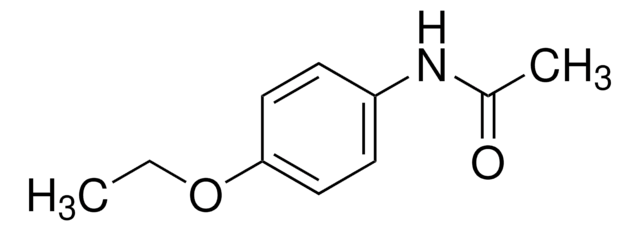1004001
USP
Acetanilide Melting Point Standard
United States Pharmacopeia (USP) Reference Standard
Synonyme(s) :
Acetanilide, N-Phenylacetamide
About This Item
Produits recommandés
Qualité
pharmaceutical primary standard
Densité de vapeur
4.65 (vs air)
Pression de vapeur
1 mmHg ( 114 °C)
Famille d'API
acetanilide
Température d'inflammation spontanée
1004 °F
Fabricant/nom de marque
USP
Point d'ébullition
304 °C (lit.)
Pf
113-115 °C (lit.)
Application(s)
pharmaceutical (small molecule)
Format
neat
Chaîne SMILES
CC(=O)Nc1ccccc1
InChI
1S/C8H9NO/c1-7(10)9-8-5-3-2-4-6-8/h2-6H,1H3,(H,9,10)
Clé InChI
FZERHIULMFGESH-UHFFFAOYSA-N
Vous recherchez des produits similaires ? Visite Guide de comparaison des produits
Description générale
For further information and support please go to the website of the issuing Pharmacopoeia.
Application
Remarque sur l'analyse
Autres remarques
Produit(s) apparenté(s)
Mention d'avertissement
Warning
Mentions de danger
Conseils de prudence
Classification des risques
Acute Tox. 4 Oral
Code de la classe de stockage
11 - Combustible Solids
Classe de danger pour l'eau (WGK)
WGK 1
Point d'éclair (°F)
321.8 °F - closed cup
Point d'éclair (°C)
161 °C - closed cup
Certificats d'analyse (COA)
Recherchez un Certificats d'analyse (COA) en saisissant le numéro de lot du produit. Les numéros de lot figurent sur l'étiquette du produit après les mots "Lot" ou "Batch".
Déjà en possession de ce produit ?
Retrouvez la documentation relative aux produits que vous avez récemment achetés dans la Bibliothèque de documents.
Les clients ont également consulté
Notre équipe de scientifiques dispose d'une expérience dans tous les secteurs de la recherche, notamment en sciences de la vie, science des matériaux, synthèse chimique, chromatographie, analyse et dans de nombreux autres domaines..
Contacter notre Service technique







